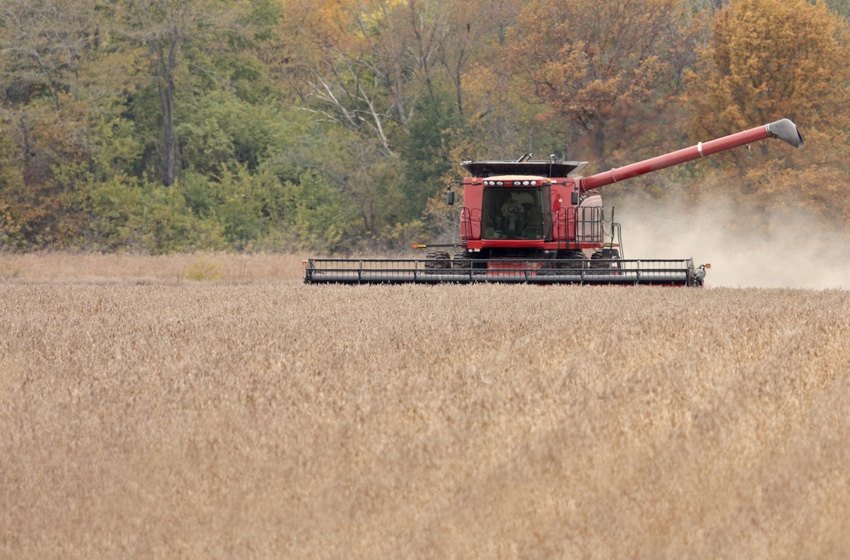
Most farm operators in the Upper Midwest have completed the 2017 corn and soybean harvest, and are finishing up with servicing equipment, as well as beginning end of the year financial bookwork. The late November and early December timeframe is also a time to keep an eye on the grain markets to watch for any short-term corn and soybean price rallies. Many farm operators are facing tight cash flow situations as we end 2017 and head into 2018, so the opportunity to turn some grain inventories into cash would be welcome.
The soybean market showed some surprising strength late in the week of Nov. 13-17, posting an 18¢ per bushel increase on Nov. 17 in both nearby and July futures prices on the Chicago Board of Trade (CBOT). This was the highest level for the nearby CBOT soybean futures price in several weeks. In addition, the basis level between the nearby CBOT and local cash soybean prices has tightened in some locations in recent weeks, which has resulted in some of the best cash soybean price bids that we have seen all fall.
Current CBOT January soybean futures closed at $9.90 per bushel on Nov. 17, which is about the same as mid-November in 2016, but is over $1 per bushel higher than mid-November in 2015. Nearby CBOT soybean futures on Nov. 17 closed near their highest closing price since late July this year. There was a pretty sharp downturn in the soybean price immediately following the Nov. 9 USDA Crop Report and World Agricultural Supply and Demand Estimate (WASDE); however, the soybean market seems to have recovered nicely in the week or so that followed. The USDA Crop Report projected record 2017 U.S. harvested soybean acreage of 89.5 million acres, and a record U.S. soybean production of 4.42 billion bushels in 2017. This compares to a total U.S. soybean production of just over 3.9 billion bushels in both 2015 and 2014.
Local cash soybean prices in southern Minnesota offer a similar scenario, with closing cash soybean prices on Nov. 17 ranging from near $9 per bushel to $9.45 per bushel, with the higher price levels being at the soybean processing plants. Cash soybean prices in other areas of the Midwest are lower levels, where a wider basis from CBOT futures prices exists. The basis level from the nearby CBOT futures price to the cash soybean price at the soybean processing plants tightened by about 15¢ per bushel from early November until Nov. 17, which has made the cash soybean price bids more competitive. The $9.45 per bushel closing cash soybean price at the some soybean processing plants on Nov. 17 was one of the highest closing prices since late July.
The current short-term strength in the soybean market is being driven by increasing demand for soybeans, both in the U.S. and globally. The U.S. soybean export levels and the domestic soybean crush levels have exceeded expectations, and were increased again in the most recent WASDE report on Nov. 9. However, the recent report also projected the U.S. soybean ending stocks, or the carryover level, at the end of the 2017-18 marketing year on August 31, 2018, to be 425 million bushels. This is 41 percent higher than the final estimated soybean ending stocks for 2016-17. The projected 2017-18 soybean ending stocks, as well as the all-important stocks-to-use ratio, would be at the highest levels in the past couple of decades. This will likely temper any large-scale soybean price rallies in the coming months, unless there are growing-season weather problems with the South American soybean crop this winter.
Many producers took advantage of some strong soybean price levels early in 2017 to forward price a portion of their expected 2017 soybean production at cash prices above $9.50 per bushel. However, the forward cash soybean prices had dropped below $9 per bushel in many areas of southern Minnesota by late summer and fall, until the recent spike in the cash price. Producers need to pay attention to cash soybean prices in the coming weeks, and take advantage of any good pricing opportunities when they exist. Many farm operators in southern Minnesota had 2017 soybean yields that were average to above average, so a cash soybean price of $9 per bushel is most likely at a profitable level.
Local cash corn prices in southern Minnesota have not been nearly as encouraging as current soybean prices. Current cash corn prices have remained near $3 per bushel or lower in recent weeks, and really have not changed much since mid-summer. There is really nothing on the horizon to suggest that the cash corn price will improve anytime soon. The Nov. 9 USDA report projected a record U.S. average corn yield of 175.4 bushels per acre, and the second-highest total U.S. corn production at 14.6 billion bushels. This only trails the 2016 record U.S. corn production level of 15.1 billion bushels, which was due to a lower level of harvested corn acres in 2017.
The projected U.S. corn ending stocks at the end of the 2017-18 marketing year on Aug. 31, 2018 is 2.48 billion bushels, which would be at the highest level in two decades. Corn basis levels between CBOT prices and local cash corn prices in recent months have been at the widest level in many years. Given the very strong 2017 corn yields in many areas of the upper Midwest, which increases the local supply of corn, those basis levels are not likely to improve anytime soon.
USDA is currently estimating the market year average (MYA) corn price for 2017-2018 in a range from $2.80-3.60 per bushel, or an average of $3.20 per bushel, which compares to $3.36 per bushel for 2016-17 and $3.61 per bushel for 2015-16. The cash corn prices in southern Minnesota have been running 10-20¢ per bushel lower than the national MYA price levels. Very little 2017 corn was forward priced before corn harvest this year, so most farm operators are storing their corn, and hoping for better prices during the first half of 2018.
It is important for farm operators to develop a good grain marketing plan for the unpriced 2017 grain that is still in storage, and to pay attention for temporary rallies in the grain markets. A good marketing plan should establish grain price targets that are based on realistic price expectations, as well as calculated crop production breakeven levels. Producers are also encouraged have target dates that are linked to grain marketing decisions and prices, especially with the unpriced corn and soybeans that are in storage. Historically, in most years with large grain supplies, such as exist in 2017, cash grain prices for old-crop corn and soybeans usually do not have large price increases following harvest, unless there is a drought or other weather problem the following crop year.
About the Author(s)
You May Also Like






